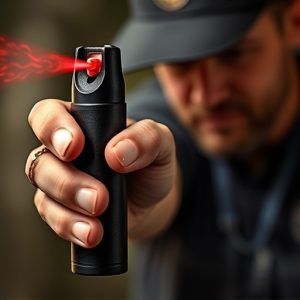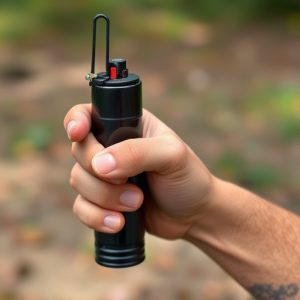Pepper Spray Management: Safety, Compliance, and Legal Considerations
Proper pepper spray storage and shelf life management are essential for law enforcement using non-le…….
Proper pepper spray storage and shelf life management are essential for law enforcement using non-lethal tools like pepper spray, tear gas, and rubber bullets in riot control situations. Best practices include storing sprays in cool, dry places (50-70°F/10-21°C) away from direct sunlight, maintaining regular inspection and rotation, and adhering to manufacturer guidelines (typically 1-3 years). Secure storage prevents unauthorized access and protects the equipment from environmental factors, ensuring optimal performance during operations while complying with legal frameworks.
Riot control agents, including pepper spray, are essential tools for law enforcement managing civil unrest. Understanding these agents’ types and their unique roles is crucial for effective, safe deployment. This article explores best practices in pepper spray storage, shelf life considerations, and the legal aspects surrounding their use and stockpile. By delving into these key areas, we aim to equip law enforcement with vital knowledge for responsible and compliant riot control operations, emphasizing the importance of proper pepper spray storage and shelf life management.
- Understanding Riot Control Agents: Types and Their Role in Law Enforcement
- Pepper Spray Storage: Best Practices for Safety and Compliance
- Shelf Life Considerations: When to Replace Riot Control Equipment
- Legal Aspects and Regulations Governing the Use and Stockpile of Riot Control Agents
Understanding Riot Control Agents: Types and Their Role in Law Enforcement
Riot control agents are chemical substances designed to disrupt, incapacitate, or disperse individuals engaging in violent or disorderly conduct. These agents play a significant role in law enforcement by providing officers with a non-lethal means of managing chaotic situations and ensuring public safety. The most common types include pepper spray, tear gas, and rubber bullets. Pepper spray, for instance, uses capsaicin to induce pain and temporary blindness, enabling police to control crowds or subdue suspects non-violently.
Understanding the proper storage and shelf life of these agents is crucial. Pepper spray, for example, should be stored in a cool, dry place away from direct sunlight to maintain its effectiveness. Manufacturers typically provide guidelines specifying the expected shelf life, which can range from 1 to 3 years depending on usage frequency and storage conditions. Law enforcement agencies must regularly audit their supply, ensuring that all equipment is within its active period for optimal performance during critical operations.
Pepper Spray Storage: Best Practices for Safety and Compliance
Proper pepper spray storage is paramount for law enforcement agencies to ensure both officer safety and compliance with legal regulations. The first step involves keeping pepper spray out of reach and away from unauthorized personnel. This can be achieved by storing it in secure, locked cabinets or containers that are accessible only to authorized officers. Ideally, these storage areas should be located in well-lit, high-traffic zones within the station to deter theft or misuse.
When storing pepper spray, it’s crucial to follow best practices regarding shelf life and conditions. Pepper spray has a limited lifespan and can degrade over time if not stored correctly. Most manufacturers recommend regular inspection and rotation of stock to ensure potency and effectiveness. Storage temperatures should be maintained between 50°F and 70°F (10°C to 21°C) to preserve the chemical’s integrity, and it should be kept away from direct sunlight or extreme heat sources. Compliance with these storage guidelines is essential not only for maintaining equipment quality but also for legal defenses in the event of use.
Shelf Life Considerations: When to Replace Riot Control Equipment
Riot control equipment, especially pepper spray, has a limited shelf life. Understanding and adhering to proper storage guidelines is crucial for maintaining effectiveness and safety. Pepper spray begins to degrade over time due to factors like heat, light, and air exposure, making it essential to store products in cool, dry places away from direct sunlight. Many manufacturers recommend replacing pepper spray after 2-3 years, but checking the product’s specific shelf life is key.
Regularly inspecting equipment for signs of damage or expiration ensures law enforcement agencies have reliable tools during critical situations. Storing items in secure, designated areas helps prevent accidental usage and protects them from environmental factors. With proper care and attention to shelf life considerations, law enforcement can maximize the effectiveness and safety of their riot control agents.
Legal Aspects and Regulations Governing the Use and Stockpile of Riot Control Agents
The legal framework surrounding riot control agents, such as pepper spray, is a complex web designed to balance public safety with individual rights. Law enforcement agencies must adhere to stringent regulations when acquiring, storing, and deploying these chemicals. International conventions, national laws, and local ordinances collectively govern their use, ensuring responsible handling and minimizing potential harm.
Riot control agents, including pepper spray, are subject to strict guidelines regarding storage and shelf life. These rules vary by jurisdiction but generally mandate secure storage facilities with controlled access, specific temperature conditions, and well-defined expiration dates. Pepper spray, for instance, has a typical shelf life of 2–3 years, after which its potency and effectiveness may degrade, necessitating disposal or replacement. Proper documentation and tracking systems are crucial to maintain compliance, ensuring law enforcement agencies have accurate records of their inventory at all times.
Riot control agents, such as pepper spray, are valuable tools for law enforcement, but proper storage and regular shelf life considerations are essential for safety, compliance, and effectiveness. By adhering to best practices for pepper spray storage and understanding the legal aspects surrounding these agents, agencies can ensure their officers are equipped with reliable resources while navigating the complexities of crowd control and public safety. Regularly reviewing and replacing outdated equipment is crucial to maintaining a robust and safe inventory.


